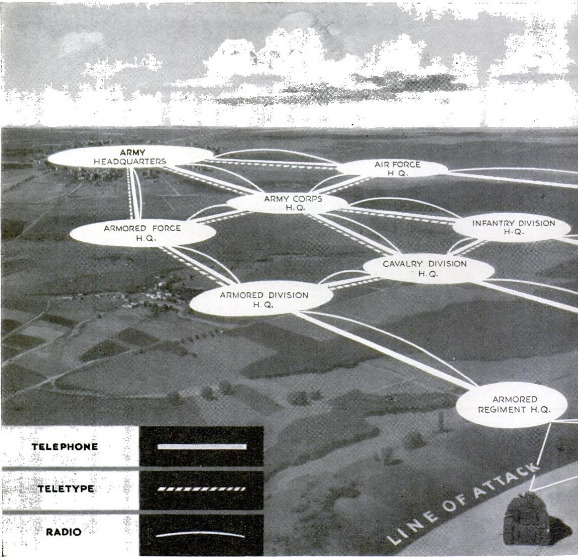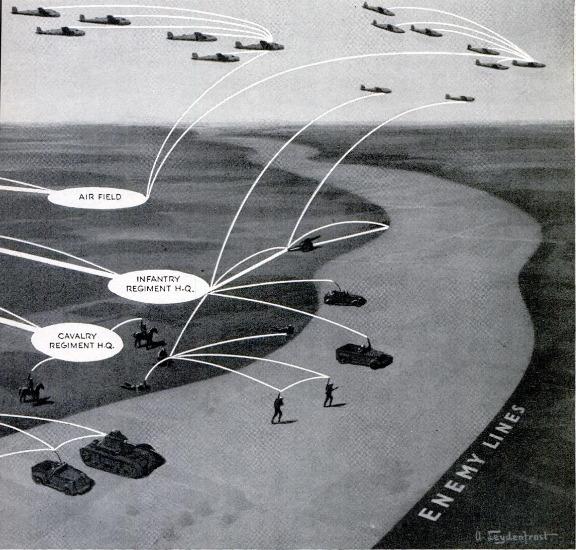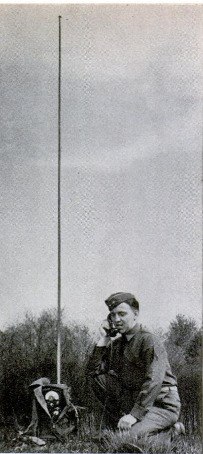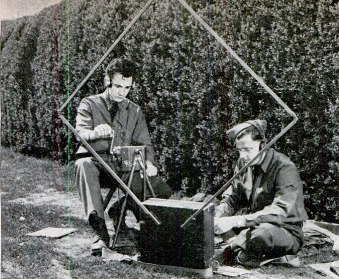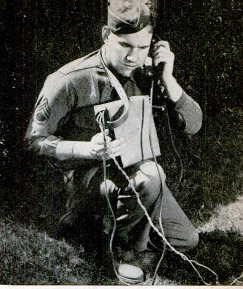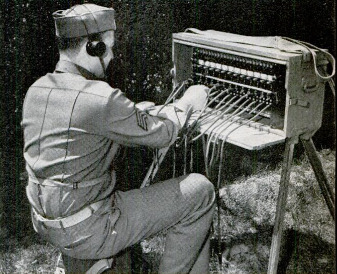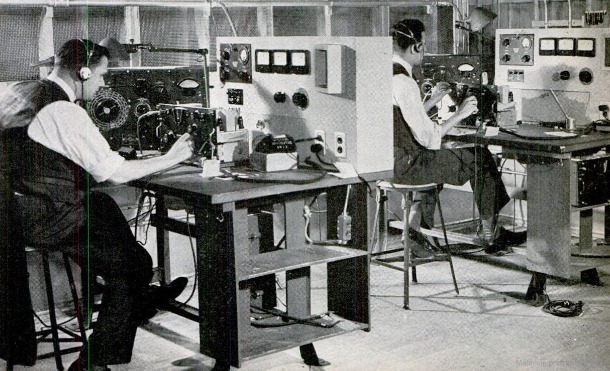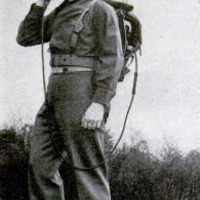-
Title (Dublin Core)
-
Army's new system
-
Article Title and/or Image Caption (Dublin Core)
-
Title: Army's new system
-
extracted text (Extract Text)
-
THE heavy tanks and dive bombers hit
the line, smash an opening. Through the
gap rush the armored divisions, the
light and medium tanks and armored cars,
fanning out, a fast backfield running inter-
ference for the infantry.
Fifty miles, 100 miles and more a day the
mechanized columns speed over the vast
grid map of battle. Their slashing end runs
flank the enemy at 35 and 40 miles an hour.
In Flanders, France, Greece, Libya, the
dashing pace of modern war has come more
and more to resemble football in a broken
field.
But the comparison breaks down com-
pletely at one point: there is no time out for
a huddle between plays. Signal communi-
cations, the army's nerve system, must be
maintained at breakneck speed continuously.
Observation planes, bombers, scout cars,
tanks, artillery, infantry must remain in
quick, instant contact with the high com-
mand; otherwise an integrated, intelligent
striking force becomes a disjointed rabble.
The marvels accomplished by the German
Army in the last two years have set our
political orators shouting for tanks, planes,
guns—a cry with which everybody agrees.
But every military man knows that the real
marvel of the German assault has not been
merely its preponderance in engines of war,
but also the precise codrdination with which
this vast amount of equipment and man-
power was used.
The Germans learned their lesson in 1914.
Entering the first World War with a primi-
tive signal corps comprising only nine bat-
talions of telegraph troops, they failed to
carry out their original assault according to
plan, largely because their communications
broke down. No such fault developed in
1940, though lines of communication were
stretched far beyond what seemed their breaking
point. That army's nerve system extended to its
very fingertips, as_ exemplified in the attack on
Fort Eben Emael. The sudden fall of that strong-
hold was one of the shocking mysteries of the at-
tack on Flanders, but it became less mysterious
when word came through that the assaulting en-
gineers, tanks, and air force were in contact by
radio throughout the attack with parachute troops
landed inside the fortifications. Even with this in-
tensive use of radio, wire channels were not neg-
lected. Right behind the tank columns came the
signal trucks, unrolling their telephone and tele-
graph wire.
Today the Signal Corps of the U. S. Army, under
Major General Joseph O. Mouborgne, is engaged in
an expansion program big and complex enough to
wrinkle the brow of any industrialist. America’s
vast prospective motorized and mechanized Army
must be provided with a communications system of
multiplicity and complexity undreamed of in the
World War. For every time you double the speed
and mobility of a military outfit you multiply its
communications problem. “And the new miracles of
radio—used only when more secret message chan-
nels are not available, must be superimposed on all
the old, sure methods—telegraph, telephone, pyro-
technics, messengers, and pigeons.
Some notion of the task involved may be obtained
by merely glancing at the radio equipment of a
single armored division. The United States armored
division is at present composed of approximately
the following forces, all carried by armored ve-
hicles:
A headquarters (in three echelons, which in op-
eration may be separated by as much as 60 miles);
1 reconnaissance battalion; 1 armored brigade of
three tank regiments, two light and one medium; 1
infantry regiment; 1 battalion of field artillery
(four batteries); 1 battalion of engineers; 1 signal
company; and service elements.
To perform its mission, and make it instanta-
neously responsive to commands while operating at
high speed, this aggregation of striking power has
basic signal equipment of about 700 radio sets, not
counting those of codperating observation planes
and dive bombers. Each commanding officer is con-
nected with his subordinates, and coperating units
of infantry, artillery, and air force maintain liaison,
through a system of nets tuned to separate radio
frequencies.
The number of nets required for this system is a
total of at least 41, plus a number of ultra-short
‘wave channels for short-range voice transmitters
within infantry and artillery units. Remember that
this is just for one division, a relatively small part
of a modern field army. Take an armored corps of
several divisions, follow it up with motorized di-
visions and divisions of foot soldiers; then put a
hostile army in the same field, also using radio; and
you have an air traffic problem which makes the
difficulties of the F.C.C. with wave lengths seem like
child's play.
Only the most rigid
control and precise calibration of instru-
ments prevents this system from becoming a
mere babble of waves in a jammed atmos-
phere. Most of the sets operate as silent re-
ceivers, authorized to transmit only in emer-
gencies. Even so, the whole matter takes on
a complex precision which is almost beyond
the imagination of those of us accustomed
only to the fuzzy tuning of our home radio
sets. The frequencies used, and the tech-
niques of avoiding confusion, are among the
closely guarded secrets of the Signal Corps.
But one method which seems sure to make
forward leaps is frequency modulation, the
new staticless form of radio. FM not only
adds new channels; it also eliminates the
interference set up by the ignition of thou-
sands of near-by gas engines.
As thus shown in the Armored Force, and
also in the air squadrons, the instruments of
communication tend today to come more and
more into the hands of the combat soldier,
intensifying the Signal Corps’ réle as a body
of specialists superimposed on the Army's
basic organization. The most striking ex-
ample of this is the tiny voice transmitter,
powered with dry cells, known as the
“walkie-talkie.” Carried in a pack, this
little radio telephone weighs only 25 pounds,
half a soldier’s ordinary load.
Obviously adapted to such melodramatic
uses as those of parachute troops or small
reconnoitering parties, the “walkie-talkie”
has far more basic value. The artillery, for
instance, has responsibility for maintaining
liaison with the infantry it is supporting;
and in the World War more artillerymen
were shot in repairing telephone lines to the
trenches than in any other way. Today such
losses would be unnecessary. When the
wires go out, the radio takes over.
Twenty years ago, when the infantry
first asked for the development of a radio
which one man could easily carry, the idea
was an utter technical impossibility. But
years of research by the Signal Corps lab-
oratories, as well as by industrial designers
who worked out the little spot-news broad-
casters used by the radio chains, have de-
veloped devices of amazing simplicity.
Today the walkie-talkie is standard equip-
ment for front-line troops, and is but the
smallest of a whole family of instruments
grading up to the heavy fixed-station trans-
mitters, all specially and ruggedly designed
for rough usage in the field. In the World
War, a radio station was a heavy affair with
a gas engine and hundreds of pounds of
equipment. Today, a front-line transmitter
with range of several miles is hardly twice
the weight of a walkie-talkie, its antenna is
a small loop, and its power is provided by a
tiny generator turned by hand cranks.
‘These small outfits are designed, provided,
and maintained by the Signal Corps of the
Army, which operates in units attached di-
rectly to the higher headquarters. In oper-
ations the Signal Corps is responsible for all
communications down to the next unit below
division headquarters, brigade or regiment
as the case may be. The smaller units han-
dle all their own signaling, with equipment
provided by the Signal Corps.
The signal service of a field army includes
two signal battalions and several specialized
companies; an army corps has one signal
battalion; and each division has a signal
company attached to headquarters. These
units, broken down into specialized platoons
and small teams, are capable of a great va-
riety of simultaneous operations.
Ordinarily the Signal Corps amounts to
about three percent of the Army, but under
the pressure of the last few months it has
expanded even more rapidly than the mili-
tary establishment as a whole. Last spring
it amounted to 35,000 men and 1,300 officers,
exclusive of National Guard units, and its
training post at Fort Monmouth, N. J., had
multiplied from a strength of only 800 to
nearly 12,000.
Here signal technicians are being turned
out by mass production. The Signal School
gave specialized three-month courses during
the last year to more than 3,000 enlisted men
and officers, and is scheduled to put through
at least 6,000 more during the year just be-
ginning. For newly inducted men a Re-
placement Training Center was opened in
March, and in the next three months gave
basic training to nearly 6,000 as linemen,
radio, teletype, and telegraph operators.
Fairly competent operators, for radio, tel-
egraph, and teletype, can be turned out in
three months; and they speed up with
further practice. Accuracy is the primary
thing, for a military message has no sense
to guide a man in sending it. Except when
an armored column is moving so fast that
secrecy is no object, and radio can be “in the
clear,” military messages are sent in code
(with groups of letters substituted for
other meanings) or in cipher (with letters
substituted for those of the actual message
so as to make an apparently incoherent
jumble). The typical military message is a
Sequence of five-letter “words” which are
merely mixtures of letters with no apparent
meanings. The Signal Corps has mechanical
devices which speed up the process of mix-
ing and unmixing the cipher, but that is no
help to the operator, who must be contin-
ually transmitting a letter-perfect stream of
alphabet soup.
The ingenuity of cryptography is exceeded
only by the art of cryptanalysis, the solving
of the secret ciphers of the enemy. This
whole field is one of the special concerns of
the Signal Corps, not only as to maintaining
the security of its own messages, but also
breaking down and reading the codes of the
enemy. The enemy is supposed to be so good
at this kind of puzzling that any code can be
broken down in from six hours to three days
at the most. In enciphering messages it is
routine, in addition to changing the key fre-
quently, to change the method of jumbling
the letters, after every five words.
Attached to each field army is a radio in-
telligence company, capable of operating
many stations on a 24-hour basis to inter-
cept enemy messages, and also a number of
radio direction-finding stations over a front
of 35 miles. A radio direction finder, with
a loop antenna rotating on a vertical axis, is
able to take a precise bearing on any select-
ed station. With two or more such bearings
from different points, the location of an
enemy transmitter may be obtained very
quickly, in much the same manner as ships
navigate by radio bearings.
America has real reason, In this emer-
gency, to be thankful that its communica-
tions system is the most highly developed in
the world. Its related industries have de-
veloped rapidly during the last quarter cen-
tury, and all the new devices of printers, tel-
etypes, facsimile, multiple circuits are quick-
1y adaptable to army use, to carry the heavy
traffic between headquarters. The skills of
wire management and maintenance are so
widespread that it is almost no problem to
get the men for the job.
But radio is the competitive frontier, and
here at the moment there is no reason for
complacency. A nation of knob-turners does
not thereby become a nation of radio tech-
nicians. Repair for the radios of thousands
of tanks is bound to become one of the
Army's greatest problems,
But that need won't become acute until
the tanks start rolling off the assembly line,
and then the radio industry will really come
into its own as a basic factor in defense.
America can tell the world that its radio in-
dustry produced 11,000,000 radio sets last
year, and 110,000,000 tubes, an increase of
2,000,000 sets from the year before. These
small army portable sets are not very com-
plex. The industry can easily supply them,
and repair men too.
-
Contributor (Dublin Core)
-
Hickman Powell (article writer)
-
Language (Dublin Core)
-
Eng
-
Date Issued (Dublin Core)
-
1941-08
-
pages (Bibliographic Ontology)
-
92-95,216-218
-
Rights (Dublin Core)
-
Public domain
-
Archived by (Dublin Core)
-
Sami Akbiyik
 Popular Science Monthly, v. 139, n. 2, 1941
Popular Science Monthly, v. 139, n. 2, 1941

